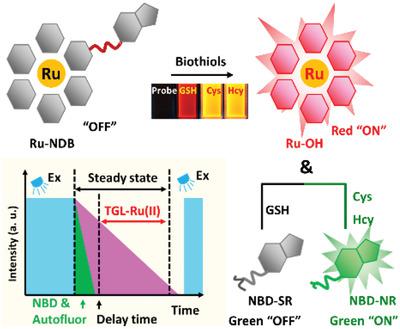Our official English website, www.x-mol.net, welcomes your feedback! (Note: you will need to create a separate account there.)
"Two Birds with One Stone" Ruthenium(II) Complex Probe for Biothiols Discrimination and Detection In Vitro and In Vivo.
Advanced Science ( IF 15.1 ) Pub Date : 2020-05-29 , DOI: 10.1002/advs.202000458 Chaolong Liu 1 , Jianping Liu 2 , Wenzhu Zhang 1 , Yong-Lei Wang 3 , Qi Liu 1 , Bo Song 1 , Jingli Yuan 1 , Run Zhang 2
Advanced Science ( IF 15.1 ) Pub Date : 2020-05-29 , DOI: 10.1002/advs.202000458 Chaolong Liu 1 , Jianping Liu 2 , Wenzhu Zhang 1 , Yong-Lei Wang 3 , Qi Liu 1 , Bo Song 1 , Jingli Yuan 1 , Run Zhang 2
Affiliation

|
In this work, a “two birds with one stone” ruthenium(II) complex probe, Ru‐NBD, is proposed as an effective tool for biothiols detection and discrimination in vitro and in vivo. Ru‐NBD is nonluminescent due to the quenching of Ru(II) complex emission by photoinduced electron transfer (PET) from Ru(II) center to NBD and the quenching of NBD emission through 4‐substitution with “O” ether bond. Ru‐NBD is capable of reacting with Cys/Hcy to form long‐lived red‐emitting Ru‐OH and short‐lived green‐emitting NBD‐NR, while reacting with GSH to produce Ru‐OH and nonemissive NBD‐SR. The long lifetime emission of Ru(II) complex allows elimination of short lifetime background and NBD‐NR fluorescence for total biothiols detection (“bird” one) by time‐gated luminescence (TGL) analysis, and the remarkable difference in luminescence color response allows discrimination GSH and Cys/Hcy (“bird” two) through steady‐state luminescence analysis. Ru‐NBD features high sensitivity and selectivity, rapid luminescence response, and low cytotoxicity, which enables it to be used as the probe for luminescence and background‐free TGL detection and visualization of biothiols in live cells, zebrafish, and mice. The successful development of this probe is anticipated to contribute to the future biological studies of biothiols roles in various diseases.
中文翻译:

“一石二鸟”钌(II)络合物探针,用于体外和体内生物硫醇的辨别和检测。
在这项工作中,提出了一种“一石二鸟”钌(II)络合物探针Ru-NBD,作为体外和体内生物硫醇检测和区分的有效工具。Ru-NBD 是不发光的,因为从 Ru(II) 中心到 NBD 的光致电子转移 (PET) 会猝灭 Ru(II) 配合物的发射,以及通过“O”醚键的 4-取代来猝灭 NBD 的发射。Ru-NBD 能够与 Cys/Hcy 反应形成长寿命的发红光的 Ru-OH 和短寿命的发绿光的 NBD-NR,同时与 GSH 反应生成 Ru-OH 和非发射的 NBD-SR。Ru(II) 复合物的长寿命发射可以消除短寿命背景和 NBD-NR 荧光,通过时间选通发光 (TGL) 分析进行总生物硫醇检测(“鸟”一),并且发光颜色响应的显着差异允许通过稳态发光分析区分 GSH 和 Cys/Hcy(“鸟”二)。Ru-NBD 具有高灵敏度和选择性、快速发光响应和低细胞毒性等特点,使其能够用作活细胞、斑马鱼和小鼠中生物硫醇的发光和无背景 TGL 检测和可视化的探针。该探针的成功开发预计将有助于未来生物硫醇在各种疾病中作用的生物学研究。
更新日期:2020-07-22
中文翻译:

“一石二鸟”钌(II)络合物探针,用于体外和体内生物硫醇的辨别和检测。
在这项工作中,提出了一种“一石二鸟”钌(II)络合物探针Ru-NBD,作为体外和体内生物硫醇检测和区分的有效工具。Ru-NBD 是不发光的,因为从 Ru(II) 中心到 NBD 的光致电子转移 (PET) 会猝灭 Ru(II) 配合物的发射,以及通过“O”醚键的 4-取代来猝灭 NBD 的发射。Ru-NBD 能够与 Cys/Hcy 反应形成长寿命的发红光的 Ru-OH 和短寿命的发绿光的 NBD-NR,同时与 GSH 反应生成 Ru-OH 和非发射的 NBD-SR。Ru(II) 复合物的长寿命发射可以消除短寿命背景和 NBD-NR 荧光,通过时间选通发光 (TGL) 分析进行总生物硫醇检测(“鸟”一),并且发光颜色响应的显着差异允许通过稳态发光分析区分 GSH 和 Cys/Hcy(“鸟”二)。Ru-NBD 具有高灵敏度和选择性、快速发光响应和低细胞毒性等特点,使其能够用作活细胞、斑马鱼和小鼠中生物硫醇的发光和无背景 TGL 检测和可视化的探针。该探针的成功开发预计将有助于未来生物硫醇在各种疾病中作用的生物学研究。



























 京公网安备 11010802027423号
京公网安备 11010802027423号